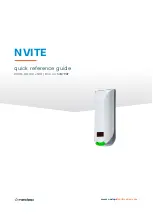
The CFSound-IV can utilize a static, user-configured IP address/mask or a dynamic NAT assigned IP
address/mask (DHCP client).
IP Mask
A sub-network or subnet is a logically visible subdivision of an IP network. All computers that belong to
the subnet are addressed with a common, identical, most-significant bit-group in their IP Address. This results
in the logical division of an IP Address into two fields; a network or routing prefix and the host identifier:
Creating a subnet by dividing the host identifier
Network Prefix
Host Identifier
↓
↓
↓
Network Prefix
Subnet Number
Host Identifier
The process of sub-netting involves the separation of network prefix and subnet number portion of the IP
Address from the host identifier. This is performed by a bitwise AND operation between the IP Address and
the IP Mask. The result yields the network address or prefix and the remainder is the host identifier. Here is
an example showing the separation of the network prefix and the host identifier from an IP Address
(192.168.1.200) and IP Mask (255.255.255.0):
Binary form
Dotted-decimal notation
IP Address
11000000.10101000.00000001.11001000
192.168.1.200
IP Mask
11111111.11111111.11111111.00000000
255.255.255.0
Network prefix
11000000.10101000.00000001.00000000
192.168.1.0
Host identifier
00000000.00000000.00000000.11001000
0.0.0.200
The purpose of sub-netting is to divide a network into smaller subnets. This is achieved by designating
some high-order bits from the host part and grouping them with the network mask to form the IP Mask. Here
the previous example is modified by moving two bits from the host part to the IP mask to form four smaller
subnets one quarter the previous size:
Binary form
Dotted-decimal notation
IP Address
11000000.10101000.00000001.11001000
192.168.1.200
IP Mask
11111111.11111111.11111111.11000000
255.255.255.192
Network prefix
11000000.10101000.00000001.11000000
192.168.1.192
Host identifier
00000000.00000000.00000000.00001000
0.0.0.8
The host identifier of all zeroes is reserved for the network ID, and the host identifier of all ones is
reserved for the broadcast address, so in general the number of hosts on a subnet is 2
N
-2 where N is the
number of bits reserved for the host portion of the address. For a 24-bit prefixed network:
Network
prefix size
IP Mask
Available
subnets
Usable Hosts
per subnet
Total usable
Hosts
24-bits
255.255.255.0
1
254
254
25-bits
255.255.255.128
2
126
252
26-bits
255.255.255.192
4
62
248
27-bits
255.255.255.224
8
30
240
28-bits
255.255.255.240
16
14
224
29-bits
255.255.255.248
32
6
192
30-bits
255.255.255.252
64
2
128
31-bits
255.255.255.254
128
2 (point-to-point)
256
Router IP Address
In computer networking a router is a node that connects two networks – such as a private network and the
public Internet. The host devices on the private network send IP packets addressed to IP Addresses on the
private network by resolving the destination MAC address into a destination IP Address through an Address
















































